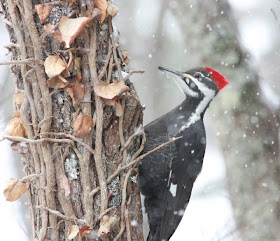Pileated woodpeckers are delightful birds to watch and it is an extraordinary experience to observe one at eye-level and have it linger for a while.
On January 28th, during a beautiful snow fall, I first heard, then located, two pileated woodpeckers foraging around the yard, visiting old growth trees both in the yard and its wooded edges. It was 19 degrees F, COLD and windy.
 Above, you see the female (top) and the male below her after she briefly landed on the same tree and they foraged together for a few minutes. Below, the male as he looks up from foraging. This bird's woodpecker movements are jerky, alert, ever scanning the environment and checking movement above and below, even though they sometimes ignore humans. Among their predators are Cooper's Hawks and the Great-horned owl.
Above, you see the female (top) and the male below her after she briefly landed on the same tree and they foraged together for a few minutes. Below, the male as he looks up from foraging. This bird's woodpecker movements are jerky, alert, ever scanning the environment and checking movement above and below, even though they sometimes ignore humans. Among their predators are Cooper's Hawks and the Great-horned owl.I finally retreated inside because I was so cold and my view was obscured by other trunks and limbs. Within 30 minutes, as I stood looking out the window at the snow and feeder birds, I saw the female as she landed on a tree at the edge of the patio. This is the sort of opportunity that calls for grabbing a coat and camera and maneuvering out the door as carefully as possible.
Above is a photo of her farther out in the yard. Notice how she has her tummy feathers fluffed with air protecting her legs from the cold and adding to her overall warmth. She has a very young face and I suspect that she is the male's offspring rather than his mate. I have seen this family together in April in seasons past as they begin their breeding season.
I opened the door and was very surprised that she ignored me and continued with her foraging. Clearly she was finding something of interest. I was torn between zooming to get close images, or pulling back to get her whole body in. I adore seeing the expression on her face, but also like the image below that shows that long sturdy tail-brace, so important in her movement and balance.
Below you can see her tongue as she probes under the bark. Woodpeckers have sticky, barbed tongues that help retrieve the insects that are hidden in crevices and underneath the bark.
Communication among family members is as facinating as watching these woodpeckers scoot up a tree, as they periodically stop to probe, pound, and extract insects. The bugle-like call can be heard on the Cornell All About Birds site (link below) and is their most famous and loudest call.
The habitat here is old growth forest with decaying trees in a suburban area where home development is interrupted by undeveloped wooded slopes. These are the kind of broken zones that support many woodpecker species and allow people and wildlife to peacefully co-exist together.
The winter months are exceptional woodpecker-viewing months in east Tennessee. Woodpeckers are easily spotted on bare trunks and tree limbs. They are busy foraging to keep warm and sustain their nutritional needs. Some woodpeckers from the mountains come down to the Tennessee Valley to spend the winter, among them the yellow-bellied sapsucker.
Above, a male yellow-bellied sapsucker forages in the yard at the same time the pileated family was present. Below, the male pileated woodpecker among large decaying limbs.
Images were taken with a Canon Rebel T2i with 100-400 Canon zoom lens.
Links and Resources:
More pileated woodpecker family posts on this blog.
Cornell All About Birds--Pileated Woodpecker. Be sure to listen to the calls.
Cornell on Yellow-bellied Sapsucker. Be sure to also listen to this sapsucker's call. He blends with tree bark so well, that the call will likely be how you learn of his presence.


















What wonderful photos! I never even thought about birds having tongues! Shows how much I know. Also loved the texture of the vines on the tree trunk. Will you be painting this?
ReplyDeleteThank you, Jane! Yes, I will probably be painting more than one version of these images. I love this bird!
DeleteSuper shots Vickie.You didn't waste the opportunity the bird in the snow presented.
ReplyDelete